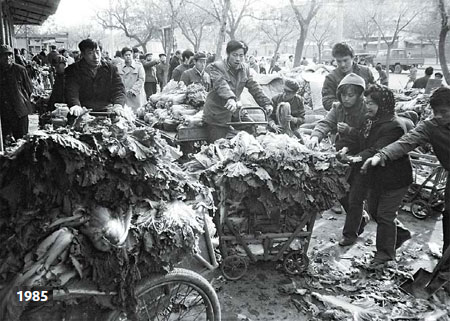
|
BIZCHINA> Wen's Lens
 |
|
Related
Fighting the cabbage wars
By You Nuo (China Daily)
Updated: 2008-12-01 10:52
   Today's urban consumers may be so used to choosing their favorite items from the supermarket shelves (as in this color photo shot in a Beijing Wal-Mart outlet) that they've forgotten how their parents used to buy vegetables. Up to this day, shopping for groceries is still called "buying vegetables," or "mai cai" in Chinese, a phrase which originally has a much narrower definition. It may partly be because unlike meat, vegetables used to be the staple in all household meals. But it may also be because, despite the large variety of vegetables on the Chinese menu, many of them used to be hard to come by. In fact, some 20 years ago, for the entire population of northern China, all the way from small towns in the western Gobi desert to major cities as Beijing and Harbin, housewives had only one green vegetable to rely on for the whole winter. It was the light green Chinese cabbage, or "bai cai" in Chinese. Of course, there were other items such as potatoes and onions. They were also cheap and could be stored in large quantities. But they were not green. Nor were they as versatile as the cabbage, serving as dumpling stuffing as well as being stir-fried. Between November and December was the time for every household to store their winter cabbage supplies. Residents used to be informed by their nearby State-owned grocery shop, by written notice and by word of the mouth, about the arrival of the cabbage shipment. On delivery day, truckloads of cabbages were piled up along the street. All families rushed to the street-side ad-hoc distribution centers, pulling whatever transport tools they could get, from tricycles to old style bamboo baby carriages. For a few days, it was if every city had fallen into a people's war of cabbage. The practice went on year in, year out. Even though many northern Chinese kids were so bored by continuous cabbage dishes in the winter, parents would still place their new orders as every winter approached. They also knew that the price would be kept very low (usually below 0.1 yuan per kilogram), thanks to the government subsidy. Yet that was the limit of the planned economy - a general equality based on a low living standard of only several low-priced major supplies. What is shown in our 1985 black-and-white photo is actually a much milder cabbage war, with far fewer people than in the early 1980s. In fact, between the mid-1980s and 1990s, households in northern Chinese cities bid farewell to the age-old practice of storing cabbages on stairways, balconies and outside windowsills. The growing market economy is now able to provide even the cities in the coldest and most arid areas with vegetables of all kinds. At the same time, not surprisingly, the 0.1-yuan-per-kilo cabbages and the street-side piles disappeared, replaced by carefully wrapped ones on supermarket shelves. Now the challenge facing the government is no longer how to feed 1.3 billion people, but how to ensure the quality of the food they get. (For more biz stories, please visit Industries)
|
主站蜘蛛池模板: 国产欧美综合精品一区二区 | 国产成人一区二区 | 亚洲加勒比 | 在线成人精品国产区免费 | 久草免费在线播放 | 手机免费毛片 | 国产v综合v亚洲欧美大另类 | 欧美ox| 国产午夜精品理论片影院 | 中文字幕乱码中文乱码综合 | 日韩福利视频精品专区 | 天天澡夜夜澡狠狠澡 | 成人免费夜片在线观看 | 日韩一区二区三区视频 | 中文字幕二区 | 97免费在线 | 成年日韩片av在线网站 | 亚洲自拍小视频 | 久热免费在线观看 | 国产一区二区三区免费 | 成人三级毛片 | 亚洲第一成人天堂第一 | 97视频在线看 | 欧美日韩美女 | 精品亚洲欧美高清不卡高清 | 精品视频在线一区 | 久久视频精品53在线观看 | 久久午夜精品视频 | 狠狠色噜噜狠狠狠米奇9999 | 国产年成美女网站视频免费看 | 美女又黄又免费 | 国产黄色在线播放 | 欧美日韩精彩视频 | 国产一区在线播放 | 久久在线国产 | 黄网站色成年小说系列 | 亚洲欧美精品网站在线观看 | 欧美日韩国产免费一区二区三区 | 美女扒开双腿让男人桶 | 欧美在线一 | 精品欧美成人高清在线观看2021 |